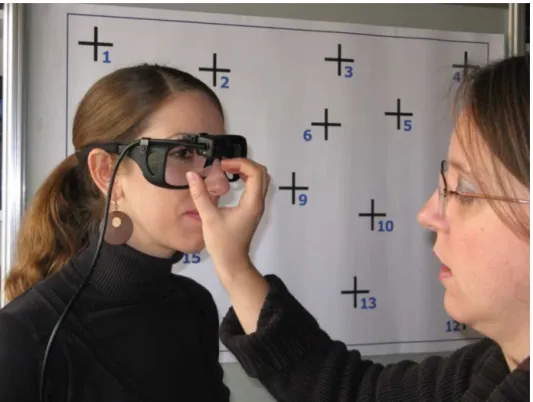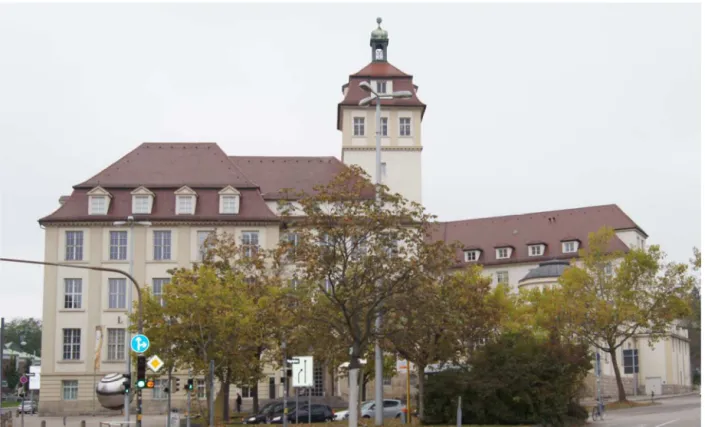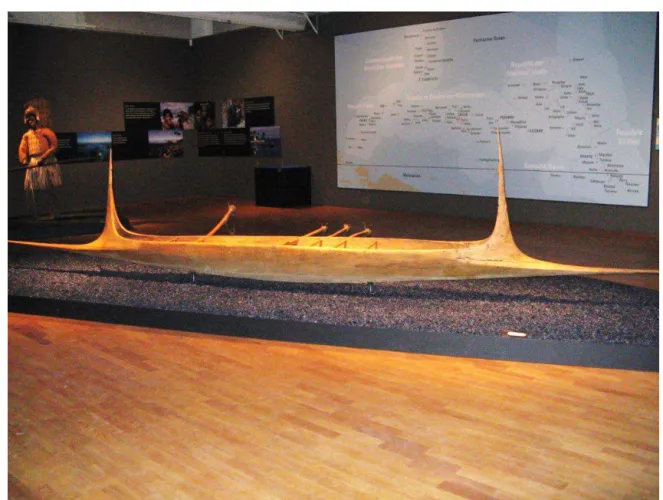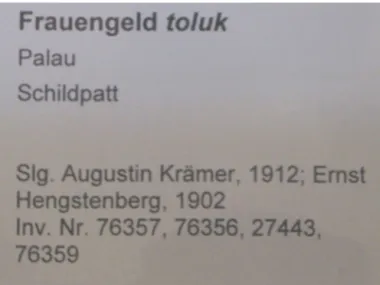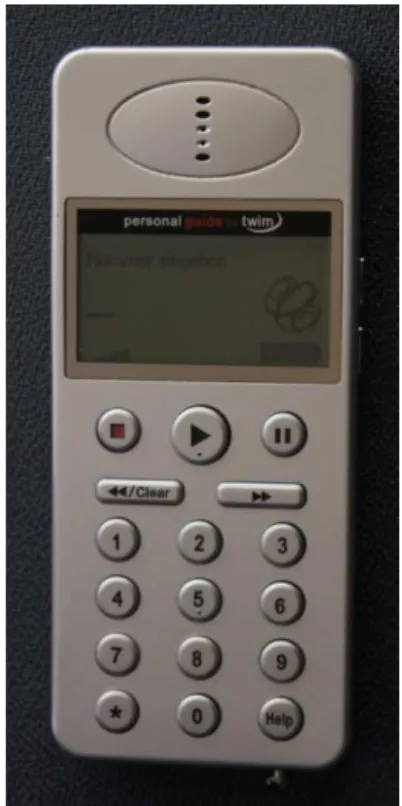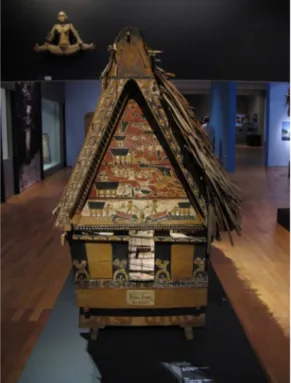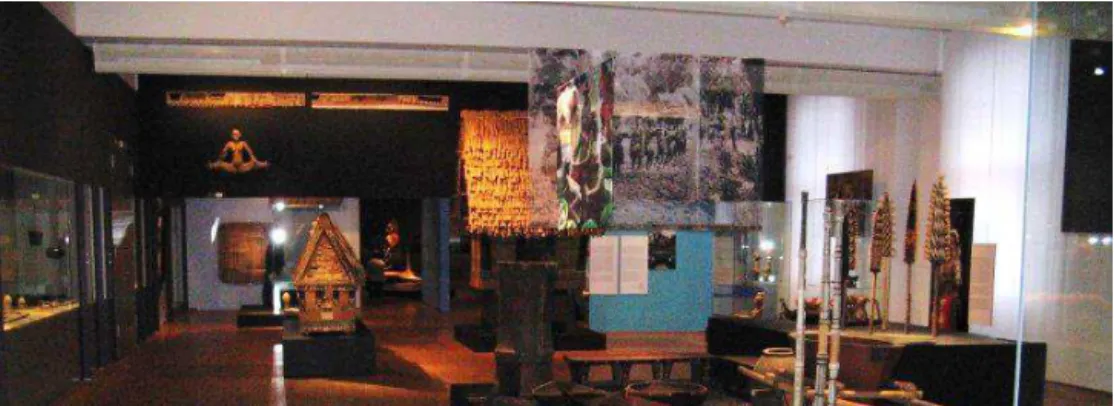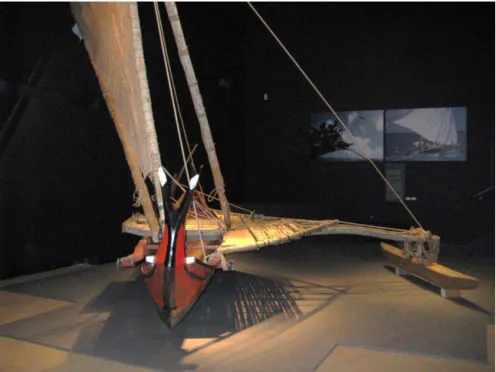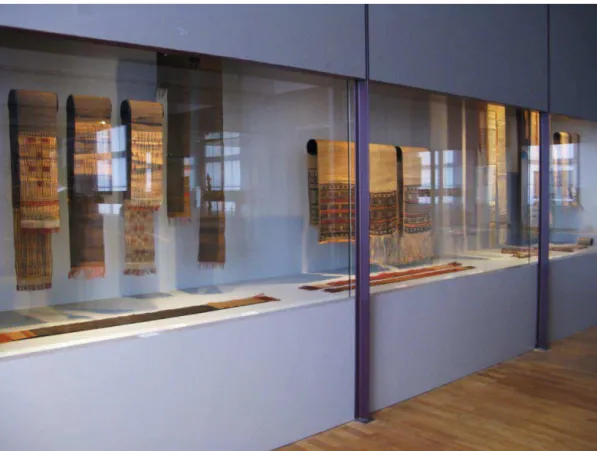Affordances, Appropriation and Experience in Museum Exhibitions:
Visitors’ (Eye) Movement Patterns and the Influence of Digital Guides
Dissertation
zur Erlangung des Doktorgrades an der Philosophischen Fakultät
der Universität zu Köln im Fach Ethnologie
vorgelegt von Kira Eghbal-Azar aus Schwäbisch-Gmünd
Köln, im Oktober 2016
1. Erster Referent: Prof. Dr. Thomas Widlok 2. Zweiter Referent: Prof. Dr. Klaus Schneider 3. Dritter Referent: Prof. Dr. Stephan Schwan
Datum der mündlichen Prüfung: 11.01.2017
Acknowledgements
This dissertation Affordances, Appropriation and Experience in Museum Exhibitions:
Visitors’ (Eye) Movement Patterns and the Influence of Digital Guides emerged from the research project Wissen & Museum: Archiv – Exponat – Evidenz (Knowledge & Museum:
Archive – Exhibit – Evidence; from 2009 until 2012) that was developed between the Institute for Empirical Studies and the Institute for Art History at the University of Tuebingen, the German Literature Archive (Deutsches Literaturarchiv, DLA) in Marbach with its affiliated museums and the Knowledge Media Research Centre (KMRC) Tuebingen, which is an extra- faculty research institute that is part of the Leibniz Association. First, I would like to thank the German Federal Ministry of Education and Research (BMBF; funding number 01UB0909) for funding this research from 2009 until 2012 and the University of Cologne for funding this research with a re-entry program position after my maternity leave in 2015.
This dissertation would never have been possible without the support of many people. I thank the curator Ingrid Heermann and the Linden-Museum in Stuttgart as well as the head of the literature museums Heike Gfrereis and the Deutsches Literaturarchiv Marbach a. N. who both opened their exhibitions for my visitor research. Furthermore I am thankful to Martin Otto- Hörbrand from the Linden-Museum for providing me with all of the information and help I asked for during the entire research process. Big thanks are also owed to Tonwelt, the audio guide company that shared their text and audio files of the “South Sea Oases: Life and Survival in the Western Pacific” exhibition and gave their permission to reprint it in this thesis. I deeply thank Andreas Sobotka from the DLA who was responsible for the multimedia museum guide (M3) and its content management (CMS) system. He introduced me into the CMS of the M3 and provided the CMS data. I am also grateful to Melanie Waldheim for kindly permitting me to quote her research results about the visitors of the Museum of Modern Literature in Marbach a. N. in my thesis.
Furthermore I would like to thank the KMRC for providing and purchasing mobile eye trackers for use in the field. Many thanks also go to the IT-Support Team of the KMRC in Tuebingen for their support throughout the research process. Furthermore I am grateful for all the students who assisted me during this research project, including Linda Greci, Marie-Luise Saile, Julia Bahnmüller, and Noreen Eberle, who all did great jobs transcribing, collecting data and supporting parts of the data analysis.
ii I am also thankful to Professor Thomas Widlok for his pragmatic advice and valuable comments and support during the whole process. Many thanks go to Professor Klaus Schneider for his openness to visitor studies and for his useful comments on the draft. I would like to thank Professor Stephan Schwan – who was also my boss at the Knowledge Media Research Centre from 2009-2012 – for his openness to anthropological theory and methods and his useful comments and support during the whole process.
I also thank the project partners at the University of Tuebingen, especially Professor Thomas Thiemeyer, our project leader, for bringing together scientists from various disciplines productively together and supporting me. The professors Anke te Heesen, Bernhard Tschofen and especially Barbara Lange are much appreciated for their interest in and comments on my research, as are my colleagues Yvonne Schweizer and Felicitas Hartmann for their interest in my work, their valuable comments and their supporting colleagueship. Additional colleagues at the KMRC provided their help include Daniela Bauer, Kristin Knipfer, Karsten Krauskopf, Tim Kühl and Daniel Wessel. Big thanks go to each of them.
Thanks also go to Emma Steinbach who proofread my translations of German original exhibition texts and digital guide texts into English as well as Lindsay Springer and Daina Crafa for proof reading this thesis.
I am also very grateful to the museum visitors who participated in my research and shared their exhibition experience and appropriation with me. They provided the basis for this research, and this thesis would not have been possible without them.
I definitely do not take all the help and support for granted. Without it this thesis would not be possible. So thank you all!
In the end, a personal note:
While being pregnant with my PhD thesis I adopted my human child, a cute little baby boy.
Being a scientist and a mom at the same time was the greatest adventure ever. Besides being grateful for all the support I got for my PhD thesis from so many people, I want to thank my husband and my son for their love and support! I especially thank my husband for his IT support. I also thank him and my son for waiting for me and being proud that “mom is writing five books”. I dedicate this thesis to my lovely husband and my lovely son. Thanks for the joint adventurous journey!
Table of Contents
List of Figures ix
List of Tables xviii
List of Acronyms xx
Prologue xxi
Abstract and Thesis Outline xxiii
1. Introduction: Behaviour of Museum Visitors and Methods in Visitor Studies
and Socio-Cultural Anthropology 1
1.1. Visitor Studies in Socio-Cultural Anthropology?! 1
1.2. Main Methods in Visitor Studies and Socio-Cultural Anthropology 4
1.3. (Mobile Eye) Tracking Studies 5
1.4. Museum Visitors’ Movement Behaviour 10
1.5. Digital Guides in Museum Exhibitions 14
1.6. Research Questions, Aims, Applied Methods and Outline 17 2. Affordances, Appropriation and Experience in Museum Exhibitions 21
2.1. Affordances in Museum Exhibitions 21
2.2. Appropriation in Museum Exhibitions 26
2.3. Experience in Museum Exhibitions 31
2.4. Museum Exhibitions 37
2.4.1. Museums and Museum Exhibitions 37
2.4.2. Ethnographic and Historico-Cultural Literature Museums 39 Ethnographic museums (displaying Oceania in Germany) 39 Historico-cultural museums and the special case of literature
museums (in Germany) 42
2.5. Conclusion 43
3. The Two Museum Exhibitions: Research at the Linden-Museum in Stuttgart and the Museum of Modern Literature in Marbach a. N. 45 3.1. The Temporary Special Exhibition “South Sea Oases: Life and Survival
in the Western Pacific” and its Audio Guide at the Linden-Museum in Stuttgart 45
3.1.1. General Description 46
The Background 46
The History 46
The Museum 48
The Exhibition 51
iv
The Digital Guide: an Audio-Guide 66
The Visitors 68
3.1.2. The Four Selected Sections 69
Section 1: The Men’s House Model from Palau 70
Section 2: The Original Outrigger Fishing Canoe from Yap 72
Section 3: The Homogenous Display Cabinet 73
Section 4: The Heterogeneous Display Cabinet 74 3.2. The Permanent Exhibition “nexus” and its Multimedia Museum Guide “M3”
at the Museum of Modern Literature (LiMo) in Marbach a. N. 75
The Background 75
The History 76
The Museum 77
The Exhibition 79
The Digital Guide: the Multimedia Museum Guide (M3) 84
The Visitors 87
3.3. Comments on the Comparability of the Two Exhibitions 87 4. Mobile Eye Tracking and Cued Retrospective Reporting – Part One:
The Results of the First Visitor Study at the Linden-Museum 89 4.1. The Mobile Eye Tracking Field Study at the Linden-Museum 91
4.1.1. Preparation 91
4.1.2. Participating Visitors 91
4.1.3. Procedure 93
4.1.4. Analysis 94
4.2. General Description of Movement Patterns 96
4.2.1. General Definition of Movement Patterns 96
4.2.2. Description of Particular Movement Patterns 98
4.2.3. Frequencies of Movement Patterns 109
Comparison of (Eye) Movement Patterns Frequencies across All Four
Sections 110
Comparison of Total Numbers between the Sections 115 Comparison of Total Numbers between Experts and Novices 116 Exemplary Detailed Comparison between Experts and Novices at
Section 3 – The Homogenous Display Cabinet 117
4.3. Cued Retrospective Reporting 118
4.4. Individual Movement Patterns and Cognitive Processes:
A Comparison between One Expert and One Novice at Each Section 119 4.4.1. Section 1: The Men’s House Model from Palau 120 4.4.2. Section 2: The Original Outrigger Fishing Canoe from Yap 122
4.4.3. Section 3: The Homogenous Display Cabinet 124
4.4.4. Section 4: The Heterogeneous Display Cabinet 127
4.5. Conclusion 132
5. Observed Movement Patterns and Cued Retrospective Reporting:
The Results of the Second Visitor Study at the Linden-Museum 138
5.1. The Systematic Observation Study 139
5.1.1. Preparation 139
5.1.2. The Observer’s Point of View at the Four Selected Exhibition Sections 140 Section 1: The Men’s House Model from Palau 140 Section 2: The Original Outrigger Fishing Canoe from Yap 141
Section 3: The Homogenous Display Cabinet 142
Section 4: The Heterogeneous Display Cabinet 142 5.1.3. Full Sample of Participating Visitors (N = 80) 143
5.1.4. Procedure 144
5.1.5. Analysis 145
5.2. Comparison with the Mobile Eye Tracking Study Results 145
5.2.1. Total Numbers 147
5.2.2. Individual Movement Patterns 147
5.3. The Influence of Audio-Guide Usage on the Observed Movement
Patterns 150
5.3.1. Total Numbers of Movement Patterns across All Four
Sections in Both Conditions 151
5.3.2. Comparison between Audio Guide Usage and Non-Usage for Each
Section and Movement Pattern 151
Section 1: The Men’s House Model from Palau 154
Section 2: The Original Outrigger Fishing Canoe from Yap 154
Section 3: The Homogenous Display Cabinet 155
Section 4: The Heterogeneous Display Cabinet 156
5.4. Cued Retrospective Reporting – Interview Sample 158
5.4.1. Interview Sample (N = 16) out of the Full Sample (N = 80) 158 v
vi 5.4.2. Comparison of Total Numbers Regarding the Cued Retrospective
Reporting between Audio Guide Users and Non-Users 160 5.4.3. Exemplary Examples of Cued Retrospective Reporting with
and without Audio Guide Usage 160
Section 1: The Men’s House Model from Palau 161
Section 2: The Original Outrigger Fishing Canoe from Yap 163
Section 3: The Homogenous Display Cabinet 165
Section 4: The Heterogeneous Display Cabinet 167
5.5. Conclusion 169
6. Mobile Eye Tracking and Cued Retrospective Reporting – Part Two:
The Results of the Visitor Study at the LiMo 172
6.1. The Field Study at the LiMo 173
6.1.1. Preparation 173
6.1.2. Participating Visitors 174
6.1.3. Procedure 176
6.1.4. Analysis 178
6.2. Generalizability of the Movement Patterns 179
6.3. Exemplary Movement Patterns and Cued Retrospective Reporting of
One Expert and One Novice without M3 Usage 185
6.4. Exemplary Movement Patterns and Cued Retrospective Reporting of
One Expert and One Novice with M3 Usage 203
6.5. Conclusion 223
7. Critical Reflection on the Applied Methods in Visitor Studies and
in Anthropological Field Research in General 228
7.1. Potentials and Limitations 228
7.2. Reactions 236
7.3. Prospects 240
8. Conclusion 244
8.1. Fulfilled Aims 244
8.2. Synopsis of Affordances, Appropriation and Experience in Museum
Exhibitions 246
8.2.1. Visitors’ Movement Patterns: The Complete Master List 248
8.2.2. The Influence of Digital Guides 251
8.2.3. Summary 252
8.3. Design Suggestions 254
8.3.1. General Design Suggestions 254
Orientation 254
Presentation Practice 254
Digital Guides 255
Target Audience 256
Staff 256
8.3.2. Specific Design Suggestions - a Selection 256
Window Shopping/Wandering Along 256
Insight 257
Alternating Gaze 257
Changing Perspective 257
8.4. Projections 257
8.4.1. The Future of Digital Guides in Museum Exhibitions 257 8.4.2. The Future of Mobile Eye Tracking in Visitor Studies and
Socio-Cultural Anthropology 258
8.4.3. The Future of the New Cognitive Science Approach in Visitor Studies 258
8.4.4. Future Visitor Studies 259
9. References 260
10. Appendices 273
10.1. The Exhibition and Digital Guide Text 273
10.1.1. The “South Sea Oases: Life and Survival in the Western Pacific”
Exhibition at the Linden-Museum 274
Introduction 274
Section 1: The Men’s House Model from Palau 275
Section 2: The Original Outrigger Fishing Canoe from Yap 277
Section 3: The Homogenous Display Cabinet 280
Section 4: The Heterogeneous Display Cabinet 282 10.1.2. The “nexus” Exhibition at the Museum of Modern Literature (LiMo) 287 10.2. Single Results of Movement Pattern Frequencies at each Section of the
“South Sea Oases: Life and Survival in the Western Pacific” Exhibition
at the Linden-Museum 288
Section 1: The Men’s House Model from Palau 288
Section 2: The Original Outrigger Fishing Canoe from Yap 290
viii
Section 3: The Homogenous Display Cabinet 292
Section 4: The Heterogeneous Display Cabinet 294
10.3. General Results of Cued Retrospective Reporting in the “South Sea Oases:
Life and Survival in the Western Pacific” Exhibition at the Linden-Museum 296 10.4. The Observation Sheet of the Observation Study in the “South Sea Oases:
Life and Survival in the Western Pacific” Exhibition at the Linden-Museum 300 10.5. The Interview Guide of the Observation Study in the “South Sea Oases:
Life and Survival in the Western Pacific” Exhibition at the Linden-Museum 301
List of Figures
Figure 1: Calibration of the ASL MobileEye (copyright by Kira Eghbal-Azar) 7 Figure 2: The ASL MobileEye designed 2004 applied 2010 at the
Linden-Museum in Stuttgart (photograph by Kira Eghbal-Azar with kind
permission of the Linden-Museum in Stuttgart) 8
Figure 3: The Linden-Museum in Stuttgart at Hegelplatz (photograph by Kira
Eghbal -Azar with kind permission from the Linden-Museum in Stuttgart) 48 Figure 4: View from the entrance into the “South Sea Oases: Life and Survival
in the Western Pacific” exhibition (photograph by Kira Eghbal-Azar
with kind permission from the Linden-Museum in Stuttgart) 51 Figure 5: Floor plan part 1 of the “South Sea Oases: Life and Survival in the
Western Pacific” exhibition at the Linden-Museum in Stuttgart (copyright
Kira Eghbal-Azar) 53
Figure 6: Floor plan part 2 of the “South Sea Oases: Life and Survival in the Western Pacific” exhibition at the Linden-Museum in Stuttgart (copyright
Kira Eghbal-Azar) 54
Figure 7: Floor plan part 3 of the “South Sea Oases: Life and Survival in the Western Pacific” exhibition at the Linden-Museum in Stuttgart (copyright
Kira Eghbal-Azar) 55
Figure 8: Floor plan part 4 of the “South Sea Oases: Life and Survival in the Western Pacific” exhibition at the Linden-Museum in Stuttgart (copyright
Kira Eghbal-Azar) 56
Figure 9: Floor plan part 5 of the “South Sea Oases: Life and Survival in the Western Pacific” exhibition at the Linden-Museum in Stuttgart (copyright
Kira Eghbal-Azar) 57
Figure 10: Floor plan part 6 of the “South Sea Oases: Life and Survival in the Western Pacific” exhibition at the Linden-Museum in Stuttgart (copyright
Kira Eghbal-Azar) 58
Figure 11: Floor plan part 7 of the “South Sea Oases: Life and Survival in the Western Pacific” exhibition at the Linden-Museum in Stuttgart (copyright
Kira Eghbal-Azar) 59
x Figure 12: Floor plan part 8 of the “South Sea Oases: Life and Survival in the
Western Pacific” exhibition at the Linden-Museum in Stuttgart (copyright
Kira Eghbal-Azar) 60
Figure 13: Floor plan part 9 of the “South Sea Oases: Life and Survival in the Western Pacific” exhibition at the Linden-Museum in Stuttgart (copyright
Kira Eghbal-Azar) 61
Figure 14: Floor plan part 10 of the “South Sea Oases: Life and Survival in the Western Pacific” exhibition at the Linden-Museum in Stuttgart (copyright
Kira Eghbal-Azar) 62
Figure 15: Huge map on the wall presenting the islands and atolls of the Western Pacific: Micronesia (photograph by Kira Eghbal-Azar with
kind permission from the Linden-Museum in Stuttgart) 63 Figure 16: Smaller map on the right of the huge map presenting the completely
Pacific region and the migration flows (photograph by Kira Eghbal-Azar
with kind permission from the Linden-Museum in Stuttgart) 64 Figure 17: Example of a label in the “South Sea Oases: Life and Survival in the
Western Pacific” exhibition (photograph by Kira Eghbal-Azar with kind
permission of the Linden-Museum in Stuttgart) 65
Figure 18: The audio guide at the Linden-Museum in Stuttgart (photograph by
Kira Eghbal-Azar with kind permission from the Linden-Museum in Stuttgart) 66 Figure 19: Section 1: The Men’s House Model from Palau (front) (photograph by
Kira Eghbal-Azar with kind permission from the Linden-Museum in Stuttgart) 70 Figure 20: Section 1: The Men’s House Model from Palau (back) (photograph by
Kira Eghbal-Azar with kind permission from the Linden-Museum in Stuttgart) 70 Figure 21: Section 1: A Particular Feature of the Men’s House Model: the Half Open
Roof (photograph by Kira Eghbal-Azar with kind permission from the
Linden-Museum in Stuttgart) 70
Figure 22: Section 1: Overview of the Men’s House Model and its Text Panel
(photograph by Kira Eghbal-Azar with kind permission from the Linden-Museum
in Stuttgart) 71
Figure 23: Section 2: The life-size outrigger canoe from Yap with photos and text panel at the back (photograph by Kira Eghbal-Azar with kind permission from
the Linden-Museum in Stuttgart) 72
Figure 24: Section 2: The life-size outrigger canoe from Yap from the outrigger side (photograph by Kira Eghbal-Azar with kind permission from the Linden-Museum
in Stuttgart) 72
Figure 25: Section 3: The Homogenous Display Cabinet (photograph by Kira
Eghbal-Azar with kind permission of the Linden-Museum Stuttgart) 73 Figure 26: Section 4: The Heterogeneous Display Cabinet (photograph by Kira
Eghbal-Azar with kind permission of the Linden-Museum Stuttgart) 74 Figure 27: The ‘Literaturmuseum der Moderne’ (LiMo) in Marbach a. N.
(photograph by Kira Eghbal-Azar by kind permission of the LiMo) 77 Figure 28: Floor plan of the LiMo (photograph by Kira Eghbal-Azar with kind
permission of the LiMo) 78
Figure 29: Floor plan of the “nexus” exhibition (not to scale; Copyright by Kira
Eghbal-Azar with kind permission of the LiMo) 81
Figure 30: View from the entrance on the four rows of the “nexus” exhibition
(photograph by Kira Eghbal-Azar with kind permission of the LiMo) 81 Figure 31: The period in the “nexus” exhibition (photograph by Kira Eghbal-Azar
with kind permission of the LiMo) 82
Figure 32: The Multimedia Museum Guides (M3) (photograph by Kira Eghbal-Azar
with kind permission of the LiMo) 85
Figure 33: Still image 1 - LONG GAZE by expert at “The Men’s House Model from
Palau” 120
Figure 34: Still image 2 - WANDERING ALONG by expert at “The Men’s House
Model from Palau” 120
Figure 35: Still image 3 - MINOR ORIENTATION GAZE by expert “The Men’s
House Model from Palau” 121
Figure 36: Still image 4 - INSIGHT by novice at “The Men’s House Model from
Palau” 120
Figure 37: Still image 5 - MINOR ORIENTATION GAZE by novice at “The Original
Outrigger Fishing Canoe from Yap” 122
xii Figure 38: Still image 6 - OBJECT SCAN Part 1 (from outrigger to canoe) by
novice at “The Original Outrigger Fishing Canoe from Yap” 122 Figure 39: Still image 7 - OBJECT SCAN Part 2 (from outrigger to canoe) by
novice at “The Original Outrigger Fishing Canoe from Yap” 123 Figures 40: Still image 8 - ALTERNATING GAZE Part 1 by expert at “The
Homogenous Display Cabinet” 124
Figures 41: Still image 9 - ALTERNATING GAZE Part 2 by expert at “The
Homogenous Display Cabinet” 124
Figures 42: Still image 10 - ALTERNATING GAZE Part 3 by expert at “The
Homogenous Display Cabinet” 125
Figure 43: Still image 11 - LONG GAZE by expert at “The Homogenous Display
Cabinet” 125
Figure 44: Still image 12 - ZOOMING CLOSER Part 1 by expert at “The
Homogenous Display Cabinet” 126
Figure 45: Still image 13 - ZOOMING CLOSER Part 2 by expert at “The
Homogenous Display Cabinet” 126
Figure 46: Still image 14 – WINDOW SHOPPING by novice at “The Homogenous
Display Cabinet” 124
Figure 47: Still image 15 – READING TEXT PANEL by expert at “The Heterogeneous
Display Cabinet” 127
Figure 48: Still image 16 – ALTERNATING GAZE (between combs) Part 1 by
expert at “The Heterogeneous Display Cabinet” 128
Figure 49: Still image 17 – ALTERNATING GAZE (between combs) Part 2 by
expert at “The Heterogeneous Display Cabinet” 128
Figure 50: Still image 18 – CHANGING PERSPECTIVE Part 1 by
expert at “The Heterogeneous Display Cabinet” 129
Figure 51: Still image 19 – CHANGING PERSPECTIVE Part 2 by
expert at “The Heterogeneous Display Cabinet” 129
Figure 52: Still image 20 – MINOR ORIENTATION GAZE by expert
at the “The Heterogeneous Display Cabinet” (jewellery) 130 Figure 53: Still image 21 – BACKWARD GAZE by expert at “The Heterogeneous
Display Cabinet” 130
Figure 54: Still image 22 – ALTERNATING GAZE (between label and exhibit)
Part 1 by expert at “The Heterogeneous Display Cabinet” 131 Figure 55: Still image 23 – ALTERNATING GAZE (between label and exhibit)
Part 2 by expert at “The Heterogeneous Display Cabinet” 131
Figure 56: Still image 24 – WINDOW SHOPPING by novice at “The Heterogeneous
Display Cabinet” 127
Figure 57: The observer’s point of view at the men’s house model from Palau
(photograph by Kira Eghbal-Azar with kind permission from the Linden-Museum
in Stuttgart) 140
Figure 58: The observer’s point of view at the original outrigger fishing canoe from Yap (photograph by Kira Eghbal-Azar with kind permission from the
Linden-Museum in Stuttgart) 141
Figure 59: The observer’s point of view behind the original outrigger fishing canoe from Yap at the text panel and photographs (photograph by Kira Eghbal-Azar with kind permission from the Linden-Museum in Stuttgart) 141 Figure 60: The observer’s point of view at the homogenous display cabinet
(photograph by Kira Eghbal-Azar with kind permission from the
Linden-Museum in Stuttgart) 142
Figure 61: The first observer’s point of view at the heterogeneous display cabinet (photograph by Kira Eghbal-Azar with kind permission from the
Linden-Museum Stuttgart) 142
Figure 62: The second observer’s point of view at the heterogeneous display cabinet (photograph by Kira Eghbal-Azar with kind permission from the
Linden-Museum in Stuttgart) 143
Figure 63: Frontal side of the men’s house model from Palau (photograph by Kira Eghbal-Azar with kind permission from the Linden-Museum in
Stuttgart) 161
Figure 64: The original outrigger fishing canoe from Yap from the outrigger side (photograph by Kira Eghbal-Azar with kind permission from the
Linden-Museum in Stuttgart) 163
Figure 65: The homogenous display cabinet from further afar (photograph by
Kira Eghbal-Azar with kind permission from the Linden-Museum in Stuttgart) 165 Figure 66: Further out-cut of the heterogeneous display cabinet (photograph by
Kira Eghbal-Azar with kind permission from the Linden-Museum in Stuttgart) 167 Figure 67: Calibration of the Locarna PT Mini (photograph by Kira Eghbal-Azar) 176
xiv Figure 68: The Locarna PT Mini designed and applied in the “nexus” exhibition
in 2010 (photograph by Kira Eghbal-Azar with kind permission from the LiMo) 176
Figure 69: Still image 1 “nexus” – expert 187
Figure 70: Still image 2 “nexus” – WINDOW SHOPPING by expert 188 Figure 71: Still image 3 “nexus” – WINDOW SHOPPING by expert 188 Figure 72: Still image 4 “nexus” – WINDOW SHOPPING by expert 189
Figure 73: Still image 5 “nexus” – expert 189
Figure 74: Still image 6 “nexus” – expert 190
Figure 75: Still image 7 “nexus” – READING IN EXHIBITS by expert 191
Figure 76: Still image 8 “nexus” – LONG GAZE by novice 187
Figure 77: Still image 9 “nexus” – READING IN EXHIBITS by novice 188 Figure 78: Still image 10 “nexus” – READING IN EXHIBITS by expert 192 Figure 79: Still image 11 “nexus” – WINDOW SHOPPING and MINOR
ORIENTATION GAZES by expert 193
Figure 80: Still image 12 “nexus” – expert 193
Figure 81: Still image 13 “nexus” – LONG GAZE by expert 194
Figure 82: Still image 14 “nexus” – READING IN EXHIBITS by novice 192
Figure 83: Still image 15 “nexus” – novice 193
Figure 84: Still image 16 “nexus” – LONG GAZE at weapon by novice 193 Figure 85: Still image 17 “nexus” – READING IN EXHIBITS by expert 195 Figure 86: Still image 18 “nexus” – READING IN EXHIBITS by novice 195
Figure 87: Still image 19 “nexus” – expert 196
Figure 88: Still image 20 “nexus”– expert 197
Figure 89: Still image 21 “nexus” – MINOR ORIENTATION GAZES by expert 197 Figure 90: Still image 22 “nexus” – WINDOW SHOPPING by expert 198 Figure 91: Still image 23 “nexus” – expert looks at shelf 5 of a display cabinet 199 Figure 92: Still image 24 “nexus” – expert looks at lower shelves of a display cabinet 199
Figure 93: Still image 25 “nexus” – expert 200 Figure 94: Still image 26 “nexus” – novice views christening robe of Thomas Mann 199 Figure 95: Still image 27 “nexus” – novice looks at shelf 5 of a display cabinet 199 Figure 96: Still image 28 “nexus” – novice views shelf 4 of a display cabinet 200 Figure 97: Still image 29 “nexus” – expert starts to activate M3 204 Figure 98: Still image 30 “nexus” – expert views floor plan on M3 205 Figure 99: Still image 31 “nexus” – expert tries to log in to the “nexus” menu via
the floor plan of the M3 205
Figure 100: Still image 32 “nexus” – expert tries to log in to the “nexus” menu via
the floor plan of the M3 for the second time 206
Figure 101: Still image 33 “nexus” – expert reads short information about “nexus” on
the floor plan in the M3 206
Figure 102: Still image 34 “nexus” – expert asks museum attendant for help – museum
attendant shows correct log in to the M3 menu 207
Figure 103: Still image 35 “nexus” – museum attendant takes pen from M3 and hands
it to the expert visitor 207
Figure 104: Still image 36 “nexus” – expert logs in to “nexus” menu of the M3 208 Figure 105: Still image 37 “nexus” – expert quickly reads the introductory text about
“nexus” in the M3 208
Figure 106: Still image 38 “nexus” – museum attendant shows log in at the display
cabinet 209
Figure 107: Still image 39 “nexus” – museum attendant shows expert the position
of the display cabinet numbers 209
Figure 108: Still image 40 “nexus” – expert logs in a display cabinet for the very first
time 210
Figure 109: Still image 41 “nexus” – M3 “nexus” menu shows the years displayed
in this display cabinet 210
Figure 110: Still image 42 “nexus” – expert selects year in M3 211
xvi Figure 111: Still image 43 “nexus” – expert struggles with selecting the right shelf
in the “nexus” menu 211
Figure 112: Still image 44 “nexus” – novice perceives log in sign to the “nexus”
menu in the M3 204
Figure 113: Still image 45 “nexus” – novice logs in to the “nexus” menu of the M3 205 Figure 114: Still image 46 “nexus” – novice reads introductory information about
the “nexus” exhibition in the M3 205
Figure 115: Still image 47 “nexus” – novice presses the screen of the M3 206 Figure 116: Still image 48 “nexus” – novice selects audio guide tour in M3 206 Figure 117: Still image 49 “nexus” – novice reads introduction to audio guide tour
in the M3 207
Figure 118: Still image 50 “nexus” – novice starts audio guide tour 207 Figure 119: Still image 51 “nexus” – novice reads information of the audio guide tour
in the M3 208
Figure 120: Still image 52 “nexus” – novice performs WINDOW SHOPPING and
searches for the correct display cabinet on eye level 208 Figure 121: Still image 53 “nexus” – novice finds the position of the display
cabinet numbers 209
Figure 122: Still image 54 “nexus” – novice searches for display cabinet number 35 209 Figure 123: Still image 55 “nexus” – novices uses M3 at display cabinet 35 210 Figure 124: Still image 56 “nexus” – novices tries to activate a written exhibit
description at display cabinet 35 in the audio guide tour of the M3 210 Figure 125: Still image 57 “nexus” – novice views exhibit 211 Figure 126: Still image 58 “nexus” – novice is READING THE M3 211 Figure 127: Still image 59 “nexus” – novice performs WINDOW SHOPPING 212 Figure 128: Still image 60 “nexus” – expert views Hesse’s manuscript “The
Glass Beads Game” 214
Figure 129: Still image 61 “nexus” – expert searches for information in the M3 215
Figure 130: Still image 62 “nexus” – expert searches for the code (label with year
and author name) 215
Figure 131: Still image 63 “nexus” – expert is READING THE M3 about Hesse’s
manuscript pages 216
Figure 132: Still image 64 “nexus” – expert views Hesse’s manuscript pages once again 217 Figure 133: Still image 65 “nexus” – expert is READING THE M3 about Hesse’s
manuscript once again 217
Figure 134: Still image 66 “nexus” – expert is READING IN EXHIBITS 218 Figure 135: Still image 67 “nexus” – expert searches for more information about
the note of Hilde Domin in the M3 219
Figure 136: Still image 68 “nexus” – experts is READING THE M3 219 Figure 137: Novice visitor about felt vision interferences 239 Figure 138: Expert visitor enters the “South Sea Oases: Life and Survival in the
Western Pacific” exhibition 247
Figure 139: The Men’s House Model from Palau from a Different Perspective (photograph by Kira Eghbal-Azar with kind permission from the
Linden-Museum in Stuttgart) 288
Figure 140: The Original Outrigger Fishing Canoe from Yap from a Different Perspective (photograph by Kira Eghbal-Azar with kind permission from the
Linden-Museum in Stuttgart) 290
Figure 141: The Homogenous Display Cabinet from a Different Perspective (photograph by Kira Eghbal-Azar with kind permission from the
Linden-Museum in Stuttgart) 292
Figure 142: A Cut-out of the Heterogeneous Display Cabinet (photograph by
Kira Eghbal-Azar with kind permission from the Linden-Museum in Stuttgart) 294
xviii List of Tables
Table 1: Temporary special exhibitions presenting parts of Oceania since the
closing of the permanent exhibition at the Linden-Museum in Stuttgart 49 Table 2: Sample of the explorative MET field study in the “South Sea Oases: Life
and Survival in the Western Pacific” exhibition at the Linden-Museum in
Stuttgart 92
Table 3: Comparison of Movement Patterns Frequencies across All Four Sections of the “South Sea Oases: Life and Survival in the Western Pacific” exhibition
at the Linden-Museum in Stuttgart 111
Table 4: Total numbers of movement patterns at each section of the “South Sea Oases:
Life and Survival in the Western Pacific” exhibition at the Linden-Museum in
Stuttgart 115
Table 5: Total numbers of movement patterns performed by experts and novices at each section of the “South Sea Oases: Life and Survival in the Western
Pacific” exhibition at the Linden-Museum in Stuttgart 116 Table 6: MET Study results – Comparison of Movement Patterns Distribution
Section 3 (The Homogenous Display Cabinet) between Experts and Novices of the “South Sea Oases: Life and Survival in the Western Pacific” exhibition
at the Linden-Museum in Stuttgart 117
Table 7: Total numbers of CRR at each section of the “South Sea Oases: Life and
Survival in the Western Pacific” exhibition at the Linden-Museum in Stuttgart 118 Table 8: Audio Guide Take-away and Real Usage in the “South Sea Oases: Life and
Survival in the Western Pacific” exhibition at the Linden-Museum in Stuttgart 144 Table 9: Comparison between the MET study and the observation study in the
“South Sea Oases: Life and Survival in the Western Pacific” exhibition at the
Linden-Museum in Stuttgart 146
Table 10: Total numbers of movement patterns across all four sections of the “South Sea Oases: Life and Survival in the Western Pacific” exhibition in both conditions 151 Table 11: Comparison between audio guide usage and non-usage at each section of the
“South Sea Oases: Life and Survival in the Western Pacific” exhibition and for
each movement pattern 153
Table 12: Frequency rates of CRR with and without audio guide usage in the
“South Sea Oases: Life and Survival in the Western Pacific” exhibition at
the Linden-Museum in Stuttgart 160
Table 13: Sample of the MET study in the “nexus” exhibition at the LiMo 175 Table 14: Table of Movement Patterns in the “nexus” exhibition at the LiMo 180-183 Table 15: Dwell time of experts and novices without M3 usage in the “nexus”
exhibition at the LiMo 186
Table 16: Dwell time of experts and novices with M3 usage in the “nexus”
exhibition at the LiMo 203
Table 17: Complete list of 26 distinct movement patterns 249 Table 18: MET Study Results – Movement Patterns Frequencies at Section 1
“The Men’s House Model from Palau” in the “South Sea Oases: Life and
Survival in the Western Pacific” Exhibition at the Linden-Museum in Stuttgart 288 Table 19: MET Study – Section 1 “The Men’s House Model from Palau” in the
“South Sea Oases: Life and Survival in the Western Pacific” Exhibition at
the Linden-Museum in Stuttgart – Interpretation of Results 289 Table 20: MET Study Results – Movement Patterns Frequencies at Section 2
“The Original Outrigger Fishing Canoe from Yap” in the “South Sea Oases:
Life and Survival in the Western Pacific” Exhibition at the Linden-Museum
in Stuttgart 290
Table 21: MET Study – Section 2 “The Original Outrigger Fishing Canoe from Yap”
in the “South Sea Oases: Life and Survival in the Western Pacific” Exhibition at the Linden-Museum in Stuttgart – Interpretation of Results 291 Table 22: MET Study Results – Movement Patterns Distribution Section 3
“The Homogenous Display Cabinet” in the “South Sea Oases: Life and
Survival in the Western Pacific” Exhibition at the Linden-Museum in Stuttgart 292 Table 23: MET Study – Section 3 “The Homogenous Display Cabinet” in the “South
Sea Oases: Life and Survival in the Western Pacific” Exhibition at the
Linden-Museum in Stuttgart – Interpretation of Results 292-293
xx Table 24: MET Study Results – Movement Patterns Distribution Section 4
“The Heterogeneous Display Cabinet” in the “South Sea Oases: Life and
Survival in the Western Pacific” Exhibition at the Linden-Museum in Stuttgart 294 Table 25: MET Study – Section 4 “The Heterogeneous Display Cabinet” in the
“South Sea Oases: Life and Survival in the Western Pacific” Exhibition at
the Linden-Museum in Stuttgart – Interpretation of Results 294-295 Table 26: Summarized Results and Interpretation of the CRR Content Analysis
(“South Sea Oases: Life and Survival in the Western Pacific” Exhibition at
the Linden-Museum in Stuttgart) 296-299
List of Acronyms
CRR Cued retrospective reporting
LiMo Literaturmuseum der Moderne (Museum of Modern Literature) M3 Multimedia museum guide
MET Mobile eye-tracker/mobile eye-tracking
xxi Prologue
Visitor and audience research in museums is a rapidly growing area (Falk & Dierking 2013) that began with the “turn to the visitor” (Hooper-Greenhill 2006: 362). Presently visitor research is becoming increasingly important in academia although it is often not yet sufficiently considered by exhibition makers when designing exhibitions (Reussner 2010).
Visitor research is conducted by various disciplines, mainly sociology, socio-cultural anthropology, psychology and educational science.
The visitor research presented in this thesis Affordances, Appropriation and Experience in Museum Exhibitions: Visitors’ (Eye) Movement Patterns and the Influence of Digital Guides was part of the German interdisciplinary cooperation project Wissen & Museum: Archiv – Exponat – Evidenz (Knowledge & Museum: Archive – Exhibit – Evidence, 2009-2012) between the Ludwig-Uhland-Institute for Empirical Studies (LUI) and the Institute for Art History at the University of Tuebingen, the German Literature Archive (Deutsches Literaturarchiv, DLA) in Marbach a. N. with its affiliated museums and the Knowledge Media Research Centre (KMRC) Tuebingen, an extra-faculty research institute that is part of the Leibniz Association. The project was funded by the German Federal Ministry of Education and Research. It consisted of four sub-projects respectively: “Spaces of Literature”
conducted by Thomas Thiemeyer and advised by Bernhard Tschofen (LUI); “Materials of Literature” conducted by Felicitas Hartmann and advised by Anke te Heesen (LUI);
“Iconicity of Literature” conducted by Yvonne Schweizer and advised by Barbara Lange (art history); and finally “Presentation Practice and Evidence Attribution” conducted by myself and advised by Stephan Schwan (KMRC). My subproject integrated socio-cultural anthropology and psychology.
The goal of this interdisciplinary cooperation project was two-fold. On the one hand the aim was to gain knowledge about museum transformations, from the archival material to the exhibit at the German Literature Archive with its affiliated museums. We sought to create an exhibition and generate knowledge about exhibitions that was newer than each discipline could provide and that was generalizable to all exhibitions. A second aim was to train scientific and museum staff at the same time. Each scientific staff member was also a trainee at the literature museums in Marbach. Hence each one of us was working between different disciplines and between academia and museums as well.
Thus it was a challenging interdisciplinary project. This project was characterized by the exchange between the disciplines and by (re)drawing boundaries between all the disciplines
xxii that are part of so-called museum studies. Each of the staff members as well as the supervising professors were open to and interested in the knowledge and practice of the other disciplines.
This project ultimately resulted in the exhibition “1912 – Ein Jahr im Archiv” (“1912 – One Year in the Archive”) and the final conference “Präsenz – ausstellen, erfahren, erforschen”
(“Presence – Exhibiting, Experiencing, Researching”) in 2012. For further information about the project see http://www.wissen-und-museum.uni-tuebingen.de/.
My tasks included conducting visitor studies in the temporary special “South Sea Oases: Life and Survival in the Western Pacific” exhibition (original title: “Südsee-Oasen: Leben und Überleben im Westpazifik”) at the Linden-Museum in Stuttgart and in the permanent “nexus”
exhibition at the Museum of Modern Literature (LiMo) in Marbach a. n. This visitor research sought distinct, recurrent and systematic eye movement patterns in museum exhibitions and described them on the micro level in order to provide design suggestions for exhibition makers. Therefore it applied, among other methods, a recent approach in visitor studies:
mobile eye tracking. Additionally it examined the influence of digital guides. Furthermore, as part of a minor aim, it investigated the differences between experts and novices.
This thesis was developed within the interdisciplinary project Knowledge & Museum with its openness, interests, aims and challenges. Hence, it will challenge its readers and ask them to be open and interested in something different from traditional anthropology. It aims to contribute to the application of new methods both in visitor studies and socio-cultural anthropology, and to initiate a new cognitive science approach in visitor studies by combining psychological and anthropological theories and methods.
xxiii Abstract and Thesis Outline
This thesis Affordances, Appropriation and Experience in Museum Exhibitions: Visitors’
(Eye) Movement Patterns and the Influence of Digital Guides emerged of the BMBF-project Knowledge & Museum. My task within this interdisciplinary project was to conduct visitor research in the permanent exhibition “nexus” at the Museum of Modern Literature in Marbach a. N. This task was complemented and extended by visitor research in the temporary special exhibition “South Sea Oases: Life and Survival in the Western Pacific” at the Linden- Museum in Stuttgart.
Visitors are usually not allowed to physically touch the exhibits in an exhibition but they are encouraged to ‘touch’ the exhibits with their gaze instead. They are invited to view exhibits.
They are invited to read labels and other information panels.
Based on such fundamental principles, the main aims of this project were to gain new knowledge about visitor eye movement behaviour1 and accompanying cognitive processes surrounding the particular affordances of exhibition design and hence particular appropriation strategies. To accomplish this, I applied a new method in visitor studies and socio-cultural anthropology: mobile eye tracking (MET). Previous visitor movement behaviour research has mainly been conducted by observation. By using MET, new insights can be gained into the micro level of visitor movement behaviour. Furthermore using MET allows us to seek the emic point of view in its very literal sense, which is the anthropological agenda as established by its founder Malinowski in 1922. The new MET method was combined with cued retrospective reporting to gain knowledge about the goals of visitors’ that underlie their attentional behaviour and thus the meaning of their movements. Thus MET works as a complementary method. The digital guides that were provided in these two exhibitions – an audio guide and a tablet like medium – were investigated in regard to their influence on visitor movement behaviour. Thus I will provide new insights into the museum experience with and without digital guides. Furthermore, it was a minor aim to investigate the differences between experts and novices.
The overarching aim of my research was not a simple evaluation of curatorial messages being transferred by the exhibits and exhibitions and received by the visitor, although this was the initial idea in exploring the field. Contrarily I chose to rely on complex basic research about
1 In the following text I will refer to (eye) movement patterns or (eye) movement behaviour always as movement patterns or movement behaviour, whereas I imply that the eye is always included in these movements.
xxiv visitors’ eye, head and body movement behaviour and their accompanying cognitive processes.
Eighteen distinct, recurrent and systematic movement patterns could be identified by applying MET in the “South Sea Oases: Life and Survival in the Western Pacific” exhibition at the Linden-Museum in Stuttgart, which could be classified according to their appearances and possible utilities. These are unique and innovative results, which make evident the fact that visitors’ movement behaviours are more complex than just stopping and attending to particular exhibits. Rather movement behaviours comprise several unconscious movement patterns that serve the exploration of exhibitions and exhibits in a detailed manner from the visitors’ own perspective. The distinctness of these movement patterns was successfully confirmed firstly, with a completely different method, systematic observation, applied in the same exhibition and secondly, in a completely different exhibition, the “nexus” exhibition at the Museum of Modern Literature in Marbach a. N., again with MET. In sum, after applying these confirmation methods, 26 movement patterns and sub-patterns were found altogether in both exhibitions.
Note that the two exhibitions are quite different as the descriptions of them in Chapter 3 will show. They are different because of their subject matter but also in many other aspects. Due to these differences these exhibitions provided a great range of typical exhibition situations, which led to the identification of this relatively large number of movement patterns (i.e., 26).
Nevertheless the comparability between both MET studies is given because both exhibitions avoid directing visitors down a single or main pathway. Instead both exhibitions allow explorative free viewing, which was the requested task of the visitors included in this study in order to elicit their eye movement patterns.
My research focuses on the influence of exhibitions’ affordances on visitors’ eye, head and body movement behaviours. These affordances are created by the selection of exhibits and digital guides and their presentation and design. For example, exhibits can be presented freestanding or in display cabinets. The design of the display cabinets may vary from being only viewable from the front side to being display cabinets made completely of glass that even have glass shelves. The presentations and designs of exhibits can be homogenous or heterogeneous. They can be presented hanging or lying on a shelf or a platform.
The influence of digital guides like the audio guide at the Linden-Museum in Stuttgart and the tablet-like guide at the Museum of Modern Literature were examined. The main finding was that digital guides direct movement patterns and focus attention in a straightforward manner.
Hence the usage of digital guides leads to more and to broader ranges of different movement patterns; thus visitors using digital media tend to be more actively engaged visually and cognitively when visiting museums than visitors who were not using digital guides. The main difference between audio guides and tablet-like guides is that audio guides allow a dual or parallel way of appropriation by viewing exhibits and listening to the audio guide at the same time, whereas tablet-like guides without the audio guide function only allow a successive but extended way of appropriation shifting between exhibit/exhibition and guide.
Besides the exhibitions’ affordances and their influence on visitors’ eye movement behaviours, investigating the difference between general content experts (socio-cultural anthropologists and literary scholars/Germanists) and novices was a minor aim; hence visitor characteristics were not collected and investigated. The comparison between experts and novices showed that individuals of both groups behave and process similarly when viewing exhibitions, although experts are more active visitors than novices. These results may reflect the selection of experts in this study, because they were not experts on the particular exhibition theme or the material culture that was exhibited. After a final review of the findings, it can be concluded that differences between visitors are primarily determined by digital guides rather than by expert status.
The results of this basic research, firstly, demonstrate that visitor movement behaviours are much more complex than previous visitor research studies have concluded. It provides evidence that 26 movement patterns including variations are used to view exhibits and exhibitions in detail from the visitors’ own perspective, and highly welcomes further research on these identified movement patterns, especially cross-cultural research. Secondly, this research will inform the influence of digital guides on visitor movement behaviour. Thirdly, findings from this research can help inform exhibition makers about exhibition design on a micro level and suggestions from these findings can be drawn to support use of visitor-centred exhibition designs. In order to present the benefits of visitor-centred exhibition designs, anthropological and psychological theories and methods are combined in a way that creates a new cognitive science approach to visitor studies. Finally yet importantly this thesis shall enable visitor researchers and socio-cultural anthropologists to decide whether MET could be advantageous and applicable for their field research.
The research and relevant background, theoretical terms, and concepts were outlined as follows:
xxvi Chapter 1 introduces visitor research in general and in socio-cultural anthropology, its methods and previous findings about visitor circulation behaviour and use of digital guides, as well as (my) reasons for conducting visitor research as a socio-cultural anthropologist. This chapter describes MET as a new method and introduces the research questions and aims in detail.
Chapter 2 introduces three main important terms and concepts that are helpful to investigate visitors’ movement patterns and the influence of digital guides: “affordance” (Gibson 1979), appropriation, and museum experience. This chapter looks briefly at museums as a research area in general, and in particular, ethnographic and literature museums.
Chapter 3 provides a detailed description of the research settings. The “South Sea Oases: Life and Survival in the Western Pacific” exhibition and its audio guide at the Linden-Museum in Stuttgart. The “nexus” exhibition and its multimedia museums guide called the ‘M3’ at the Museum of Modern Literature (LiMo) in Marbach a. N., including floor plans, photographs and original texts of the exhibitions.
Chapter 4 describes the results of the first MET study conducted in the “South Sea Oases:
Life and Survival in the Western Pacific” exhibition at the Linden-Museum in Stuttgart.
Eighteen distinct, recurrent and systematic movement patterns are identified and described in detail. Additionally, this chapter provides the frequencies of the movement patterns at four selected sections demonstrating the level of frequencies and hence level of affordances’
perception (primary, secondary, tertiary and no frequencies). Furthermore it focuses exemplarily on movement behaviour and accompanying cognitive processes of experts and novices.
Chapter 5 describes the results of the systematic observation study conducted in the “South Sea Oases: Life and Survival in the Western Pacific” exhibition at the Linden-Museum in Stuttgart at four selected sections. It describes the confirmation of the movement patterns and the investigation of the audio guide’s influence on these patterns. Furthermore this chapter provides examples of cognitive processes reported by a subset of visitors that were additionally interviewed directly after they were observed.
Chapter 6 describes the results of the second MET study conducted in the “nexus” exhibition at the LiMo. It proves most of the movement patterns identified in the “South Sea Oases: Life and Survival in the Western Pacific” exhibition at the Linden-Museum in a completely different exhibition and thus provides first evidence for possible generalizability of the research findings. Additionally further movement patterns were identified in the “nexus”
